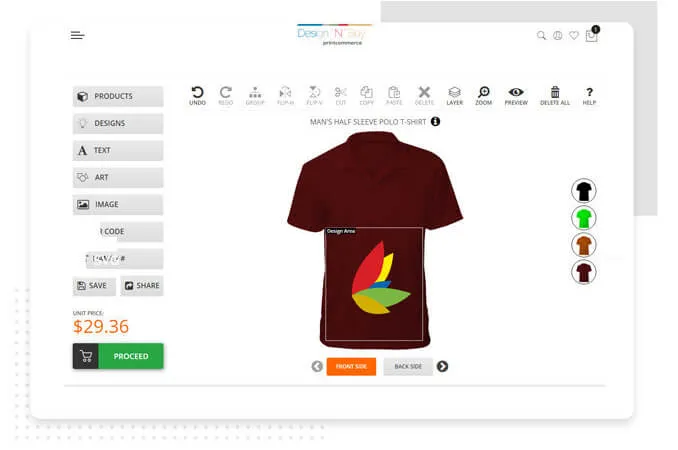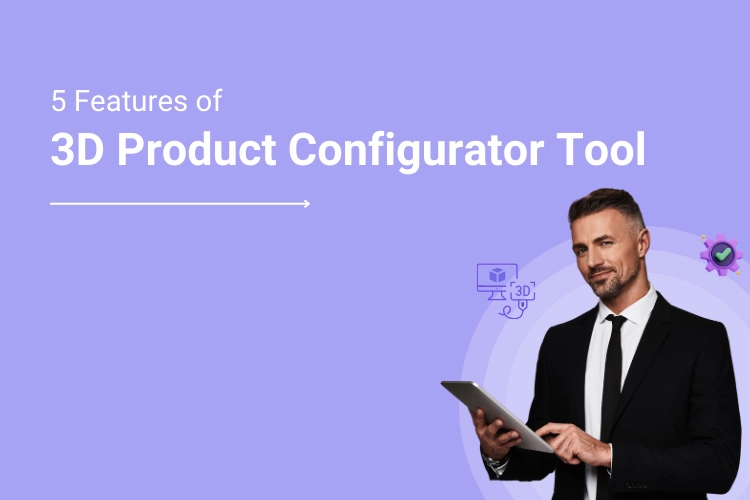Personalized and customized products have become customer preferences rather than being a luxury. With the growing customer expectations and willingness to pay extra for their desired customization, the demand for the web-to-print 3D Product Configurator tools has increased. But, with the increasing demand for customized products and with the evolution of it, the expectations of customers are also increasing.
For instance, when we talk about gift personalization, people nowadays have a lot of creative ideas and they want product customization software that helps them execute their vision. Millennial and Generation Z are looking for such apparel, sneakers and other such products that are not easily available in an offline store so that their products remain exclusive or limited product. Thus, while the business is high in demand and has a lot of potential as well as scope, the success of your business boils down to the capabilities of your product configurator tool!
While customization trends keep evolving with the market expectations and customer expectations, it is all about how fast your Product Configuration Software allows you to adopt that trend and offer it to your customers in terms of customization.
5 Features of 3D Product Configurator Tool
A 3D product configurator is an immersive online design tool that empowers customers to interactively visualize a product in a dynamic 360-degree rendering. By offering the ability to view customized products from every angle, this technology significantly enriches the customer’s visualization experience. Thus, when you are in the market finding your ideal product configurator tool that aligns with your business goals and customer expectations, the product must have the following 5 features to ensure that it provides an optimum return on investments:
1. Customization Capabilities (Dynamic Solution):

When you are choosing Web-to-print 3D product view configurator software, whether you are looking for a standard solution or a custom web-to-print solution, make sure that the solution not only caters to your current customization requirements but also your future updates. Because of social media and other content platforms, customization and product trends keep evolving constantly. Thus, when you choose it, ensure that the tool empowers you to incorporate that trend as a customized product.
This can happen when you choose dynamic software that allows you to quickly create relevant design templates and enlist them on your e-commerce platform as a product. Apart from that, the tool must also allow your customers to make desired changes to the template and design their product according to their expectations. When you have such a tool that provides quick and efficient customization capabilities, you can grab on all the market opportunities and that will allow you to keep your platform relevant to your customers.
2. Customization options:
People nowadays love to experiment with products especially when we talk about consumer products. Whether it is mugs, pillows, apparels, sneakers or other such products, make sure your custom product configurator tool allows your customers to play around with your software and get their desired custom design. Thus, when you choose it, make sure it has all the customization options such as image, icons, photos, text, clip art and all such other options. Also, confirm if the custom product configurator tool provider will provide you with the required software updates to catch up with market trends.
3. Personalized Experiences:
Personalization in terms of customer experiences has become a larger trend across the internet just like personalized products. Thus, not only your e-commerce platform but your tool must also provide personalized experiences to your customers. The tool must provide your customers personalized experiences such as they must be able to look at their previous purchases, allow them quickly make previous orders, save their previous designs on their profile and other such things. This will help your platform to deliver satisfactory and delightful experiences to your customers which would result in a positive brand image.
4. Quick and Seamless Transitions:
Small things contribute towards larger experiences. Thus, when you choose it, make sure it has a quick loading time as no matter how good your product is; if it is slow then customers will eventually bounce from your product to your competitors! Apart from that, the transition from your e-commerce platform to your eCommerce 3D product configurator software must be seamless. For this ensure that the tool provider offers color and theme design customizations that match with your e-commerce platform.
5. Mobile Responsiveness:
Last but definitely not the least; your tool must work perfectly on all the handheld devices and all the possible screen sizes. People nowadays are more relied on their smartphones and tablets for shopping than they are on their desktops and laptops. Thus, make sure that your tool works perfectly on all the mobile devices.
With growing market also grows the customer expectations. E-commerce itself is evolving with each passing day and introducing new revolutions like AR and VR platforms and other such technologies. Product Customization is not just a passing trend but a customer preference and it is here to stay. But, to grow in the market your tool must empower you and not become a liability. Thus, make sure that your tool has all the above-mentioned features and also others to help you gain a competitive edge in the market.
FAQs
What is a 3D product configurator tool for web-to-print?
A 3D product configurator tool for web-to-print is a digital solution that allows customers to customize and visualize products in three dimensions before placing an order through a web-based platform.
How does a 3D product configurator tool work for web-to-print businesses?
A 3D product configurator tool lets users personalize products by selecting different attributes such as colors, sizes, materials, and design elements. The tool generates a dynamic 3D visual representation of the customized product in real-time.
Can a 3D product configurator tool integrate with e-commerce platforms?
Yes, our 3D product configurator tool are designed to seamlessly integrate with e-commerce platforms, enabling customers to configure and purchase products directly from your website.
What types of products can be customized using a 3D configurator tool?
A wide range of products can be customized, including apparel, footwear, accessories, promotional items, packaging, and more. The versatility of the tool makes it suitable for various web-to-print businesses.
How can a 3D configurator improve customer engagement?
A 3D configurator provides an interactive and immersive experience, allowing customers to participate in the design process actively. This engagement can lead to higher customer satisfaction and increased brand loyalty.
Can a 3D configurator tool be used on mobile devices?
Yes, our 3D configurator tool is responsive and can be accessed and used on various mobile devices, enhancing accessibility for customers.
Can a 3D configurator tool help reduce returns and enhance order accuracy?
Absolutely. The visual representation provided by a 3D configurator tool helps customers make informed choices, reducing the likelihood of ordering errors and subsequently minimizing product returns.
How can I choose the right 3D configurator tool for my web-to-print business?
Consider factors such as ease of integration, customization options, compatibility with your e-commerce platform, user-friendliness, analytics capabilities, and reviews from other businesses in your industry.
Can a 3D configurator tool be used for B2B and B2C businesses?
Yes, a 3D configurator tool can be used for both B2B and B2C businesses, providing personalized and engaging experiences for all types of customers.




